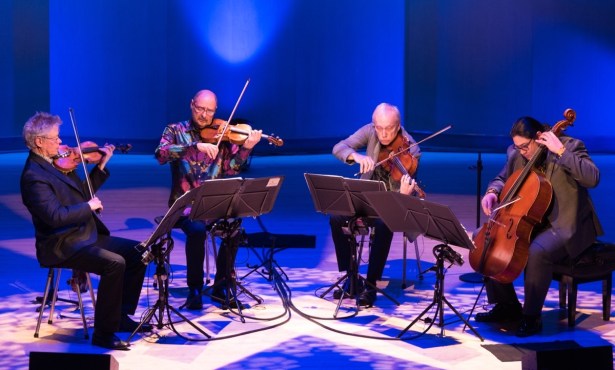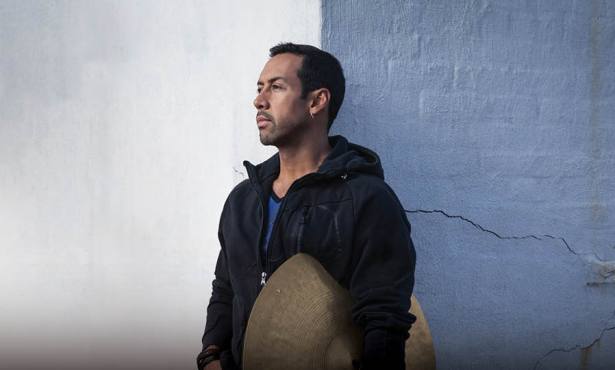Charles Lloyd Returns to the Lobero with Sangam
Percussion-Intensive Trio Celebrates 10 Years of Music Making

There is a poem by Walt Whitman in which the poet’s elastic identity migrates around the globe with the tides of humanity, from ancient Asia to modern America, only to end up facing west from California’s shore. With Manifest Destiny exhausted, the restless seeker can turn nowhere except within himself: “But where is what I started for so long ago? / And why is it yet unfound?” The poem anticipated many seekers of the 20th century who turned west to find an inner east, but few people illustrate the point better than pioneering jazz woodwind player and composer Charles Lloyd. Lloyd’s young star rose fast; he introduced the flower-power generation to the joys of jazz with his fifth album, 1966’s Forest Flower (which would go on to sell more than a million copies). He later stunned the music world by renouncing it all at the pinnacle of his success, retreating to Big Sur’s lonely coastline in the early 1970s to study Vedanta and practice meditation. “Something has happened to me where I’ve made a kind of crossover before leaving,” he said when we interviewed him last week. “You have to die to the world to not be attached.”
But Lloyd was not destined to remain buried. In 1981, the brilliant 18-year-old French pianist Michel Petrucciani (whose stature was stunted by the genetic disorder osteogenesis imperfecta) showed up at Lloyd’s doorstep and appealed to him to return to the jazz world. They played together, and the retired reedman was profoundly moved: “I had to introduce this beautiful soul to the world,” he explained. The tour that followed (which opened at the Lobero Theatre) was a sensation. Audiences were affected by the sight of the tall Lloyd carrying the handicapped Petrucciani to the piano bench, only then to experience a bright flight through musical spaces that knew no limits. A near-fatal illness a few years later compelled Lloyd to again sift his inner essentials. His subsequent recovery, at age 50, signaled a new era and an eruption of unprecedented creativity that has since flowed across 25 years of writing, experimenting, touring, and mentoring, much of it recorded in a series of acclaimed ECM albums. Producer Manfred Eicher said of Lloyd’s 1989 comeback, “All the meat is gone, only the bones remain.”
The Sangam trio began as a 2004 tribute concert at the Lobero Theatre for Lloyd’s longtime spiritual friend and musical colleague, the late drummer Billy Higgins. Lloyd brought together two percussionists: classical Indian tabla master Zakir Hussain and the gifted American drummer Eric Harland, who also plays in Lloyd’s New Quartet. The Sanskrit word sangam, Lloyd explained, “starts out meaning ‘confluence,’ and it refers to the three rivers in India: the Ganges, the Jamuna, and the Saraswati, which flows underground. These rivers meet up and go to the sea, much like these three spirits — Eric Harland, Zakir Hussain, [and myself].” Although Sangam has subsequently performed elsewhere, including India and Montreal, this Saturday’s show will be the trio’s first return to its birthplace.
In addition to playing tabla, Hussain also sings in the trio. “You know what happened with that was — this is strange,” said Lloyd, “He wasn’t a singer [before Sangam], but he came out here to UCSB [in 2001] to play a concert with a cousin of his, a great singer and sitar player [Shujaat Husain Khan]. I just loved that concert so much, and I always would say to Zakir that I wish someone would sing with us. He realized I was calling for that, and that’s when he started singing [the song] ‘Guman.’ See, when I first heard him play, it was so soulful; it was like a throwback to earlier times when I heard these old blues guys coming from a source. He comes from that deep source, the Ganges and stuff.”
As far as Harland goes, “[Eric] was born in Texas, and he became a Baptist minister when he was very young, but then the big ministry hit him,” Lloyd said. “He just sent me a track of a song that he recorded based on a piece of mine, called ‘Sea of Tranquility.’ He took that germ, and he built a track around it, and he said, ‘I want to pay tribute to you as my meditative teacher.’ But the point is not that — I don’t call myself that. I’m a student. But he heard something in that, and it inspired him. When he [first] came to me, he had a limited language. That was just flower; he’s [now] coming to himself.”
The year 2013 was a milestone for Lloyd. His 75th birthday was celebrated with a concert at the Temple of Dendur in N.Y.C.’s Metropolitan Museum of Art, featuring personnel from his 2010 Athens concert. A new album of duets with pianist Jason Moran, Hagar’s Song, was released, honoring the memory of Lloyd’s great-great-grandmother who was a slave. Festival International de Jazz de Montréal honored Lloyd with the 2013 Miles Davis Award, and an extravagant concert celebration stretched three consecutive nights. Finally, a superb bio-documentary about Lloyd, Arrows into Infinity, directed by his wife and business partner, Dorothy Darr, premiered at the Santa Barbara International Film Festival. The mystery is how Lloyd continues to sustain such a high level of artistry that is at once inspired and effortless. He puts it simply: “You find a way to share something with your fellow seekers here. I think we’re all seekers; it’s just that we don’t know it.”
4•1•1
Charles Lloyd returns to the Lobero Theatre (33 E. Canon Perdido St.) alongside Zakir Hussain and Eric Harland as Sangam on Saturday, March 8, at 8 p.m. Call (805) 963-0761 or visit lobero.com for tickets and info.



